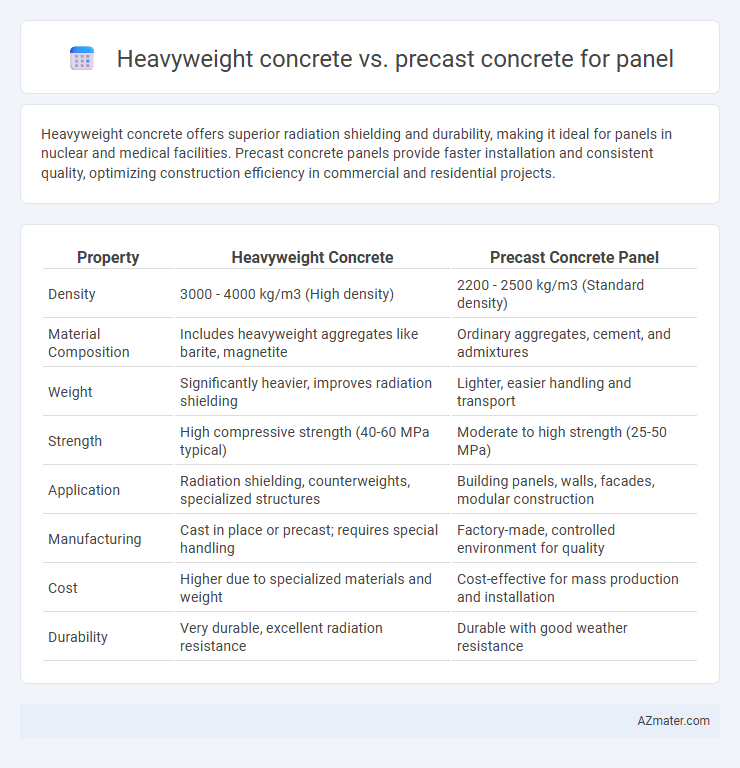Heavyweight concrete offers superior radiation shielding and durability, making it ideal for panels in nuclear and medical facilities. Precast concrete panels provide faster installation and consistent quality, optimizing construction efficiency in commercial and residential projects.
Table of Comparison
| Property | Heavyweight Concrete | Precast Concrete Panel |
|---|---|---|
| Density | 3000 - 4000 kg/m3 (High density) | 2200 - 2500 kg/m3 (Standard density) |
| Material Composition | Includes heavyweight aggregates like barite, magnetite | Ordinary aggregates, cement, and admixtures |
| Weight | Significantly heavier, improves radiation shielding | Lighter, easier handling and transport |
| Strength | High compressive strength (40-60 MPa typical) | Moderate to high strength (25-50 MPa) |
| Application | Radiation shielding, counterweights, specialized structures | Building panels, walls, facades, modular construction |
| Manufacturing | Cast in place or precast; requires special handling | Factory-made, controlled environment for quality |
| Cost | Higher due to specialized materials and weight | Cost-effective for mass production and installation |
| Durability | Very durable, excellent radiation resistance | Durable with good weather resistance |
Introduction to Heavyweight and Precast Concrete Panels
Heavyweight concrete panels are composed of dense aggregates such as barite, magnetite, or steel shot, providing enhanced radiation shielding and superior soundproofing properties ideal for specialized construction applications. Precast concrete panels are factory-manufactured components designed for rapid onsite installation, offering consistent quality, reduced labor time, and increased structural efficiency for commercial and residential buildings. Comparing the two, heavyweight concrete excels in protective functions, while precast panels prioritize construction speed and dimensional accuracy.
Material Composition: Heavyweight vs Precast Concrete
Heavyweight concrete incorporates dense aggregates such as barite, magnetite, or hematite, significantly increasing its density and radiation shielding properties compared to standard concrete. Precast concrete panels are typically made with normal weight aggregates like gravel and sand, providing controlled quality and uniformity through factory production but without the enhanced density of heavyweight mixes. The material composition in heavyweight concrete focuses on achieving high mass and durability, whereas precast concrete emphasizes fabrication precision and ease of installation.
Manufacturing Processes Compared
Heavyweight concrete panels are produced by incorporating dense aggregates such as barite or magnetite to increase mass, requiring specialized mixing and curing conditions to ensure uniform density and strength. Precast concrete panels are manufactured in controlled factory environments using standard mixes, offering precise dimensional control and faster production cycles through automated molds and curing chambers. The manufacturing process of heavyweight concrete demands longer curing times and strict quality control to achieve desired radiation shielding and load-bearing properties, whereas precast concrete focuses on repetitive, scalable production with enhanced surface finishes.
Structural Performance and Strength
Heavyweight concrete panels offer superior structural performance due to their high-density aggregates, providing enhanced mass and improved impact resistance compared to standard precast concrete. Precast concrete panels, while offering controlled quality and uniform strength through factory production, typically exhibit lower density and weight, affecting their load-bearing capacity in certain applications. The increased compressive strength and durability of heavyweight concrete make it ideal for applications requiring enhanced shielding, structural stability, and long-term resilience.
Installation and Construction Efficiency
Heavyweight concrete panels offer superior radiation shielding and durability but often require more extensive on-site handling and longer curing times, impacting installation speed. Precast concrete panels are manufactured off-site under controlled conditions, enabling faster installation, consistent quality, and reduced labor costs on the construction site. Choosing precast panels can significantly improve overall construction efficiency by minimizing weather delays and streamlining workflow.
Durability and Longevity
Heavyweight concrete panels offer superior durability due to their dense aggregate composition, which enhances resistance to radiation, fire, and impact, making them ideal for specialized structural applications. Precast concrete panels provide consistent quality and high durability through controlled factory conditions, ensuring long-term structural integrity and reduced maintenance. The longevity of heavyweight concrete is often greater in harsh environments, while precast concrete excels in uniformity and speed of installation, contributing to extended service life.
Insulation and Acoustic Properties
Heavyweight concrete panels offer superior sound insulation and acoustic dampening due to their high density and mass, effectively reducing noise transmission in building applications. Precast concrete panels provide consistent thermal insulation performance with the option to integrate insulating layers or cores, enhancing energy efficiency. The choice between heavyweight and precast concrete panels depends on project-specific requirements for acoustic control and thermal insulation levels.
Cost-Effectiveness and Budget Considerations
Heavyweight concrete panels, typically composed of dense aggregates like barite or magnetite, offer superior radiation shielding and durability but come with higher material and transportation costs compared to precast concrete panels. Precast concrete panels, manufactured in controlled factory settings, provide cost savings through reduced onsite labor, faster installation, and minimized waste, making them more budget-friendly for large-scale projects. Evaluating project-specific needs for strength, durability, and shielding against budget constraints is crucial in selecting between heavyweight and precast concrete panels.
Environmental Impact and Sustainability
Heavyweight concrete panels, often made with dense aggregates like magnetite or barite, provide enhanced radiation shielding but have a higher carbon footprint due to energy-intensive mining and processing. Precast concrete panels offer improved environmental benefits by reducing onsite waste, enabling precise material control, and allowing for reuse or recycling of forms, significantly lowering overall CO2 emissions. The sustainability of precast concrete is further supported by its potential integration of supplementary cementitious materials (SCMs) such as fly ash or slag, which reduce cement content and embodied energy compared to heavyweight concrete production.
Choosing the Right Concrete Panel for Your Project
Heavyweight concrete panels, composed of dense aggregates like iron or barytes, offer superior radiation shielding and sound insulation ideal for industrial or medical facilities, whereas precast concrete panels provide rapid installation and consistent quality suited for commercial buildings and repetitive architectural designs. Selecting the right concrete panel depends on project-specific requirements such as load-bearing capacity, environmental exposure, installation time, and budget constraints. Understanding the functional demands and structural criteria ensures optimal performance and durability in your construction project.

Infographic: Heavyweight concrete vs Precast concrete for Panel
 azmater.com
azmater.com